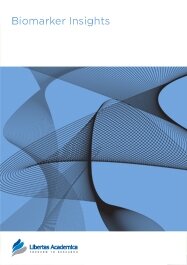

Publication Date: 08 Feb 2011
Type: Rapid Communication
Journal: Biomarker Insights
doi: 10.4137/BMI.S6383

Inorganic arsenic is a known environmental toxicant and carcinogen of global public health concern. Arsenic is genotoxic and cytotoxic to human keratinocytes. However, the biological pathways perturbed in keratinocytes by low chronic dose inorganic arsenic are not completely understood. The objective of the investigation was to discover the mechanism of arsenic carcinogenicity in human epidermal keratinocytes. We hypothesize that a combined strategy of DNA microarray, qRT-PCR and gene function annotation will identify aberrantly expressed genes in HaCaT keratinocyte cell line after chronic treatment with arsenic trioxide. Microarray data analysis identified 14 up-regulated genes and 21 down-regulated genes in response to arsenic trioxide. The expression of 4 up-regulated genes and 1 down-regulated gene were confirmed by qRT-PCR. The up-regulated genes were AKR1C3 (Aldo-Keto Reductase family 1, member C3), IGFL1 (Insulin Growth Factor-Like family member 1), IL1R2 (Interleukin 1 Receptor, type 2), and TNFSF18 (Tumor Necrosis Factor [ligand] SuperFamily, member 18) and down-regulated gene was RGS2 (Regulator of G-protein Signaling 2). The observed over expression of TNFSF18 (167 fold) coupled with moderate expression of IGFL1 (3.1 fold), IL1R2 (5.9 fold) and AKR1C3 (9.2 fold) with a decreased RGS2 (2.0 fold) suggests that chronic arsenic exposure could produce sustained levels of TNF with modulation by an IL-1 analogue resulting in chronic immunologic insult. A concomitant decrease in growth inhibiting gene (RGS2) and increase in AKR1C3 may contribute to chronic inflammation leading to metaplasia, which may eventually lead to carcinogenicity in the skin keratinocytes. Also, increased expression of IGFL1 may trigger cancer development and progression in HaCaT keratinocytes.
PDF (632.99 KB PDF FORMAT)
RIS citation (ENDNOTE, REFERENCE MANAGER, PROCITE, REFWORKS)
BibTex citation (BIBDESK, LATEX)
XML
PMC HTML
I would like to extend my gratitude for creating the next generation of a scientific journal -- the science journal of tomorrow. The entire process bespoke of exceptional efficiency, celerity, professionalism, competency, and service.

All authors are surveyed after their articles are published. Authors are asked to rate their experience in a variety of areas, and their responses help us to monitor our performance. Presented here are their responses in some key areas. No 'poor' or 'very poor' responses were received; these are represented in the 'other' category.See Our Results
Copyright © 2013 Libertas Academica Ltd (except open access articles and accompanying metadata and supplementary files.)
FacebookGoogle+Twitter
PinterestTumblrYouTube